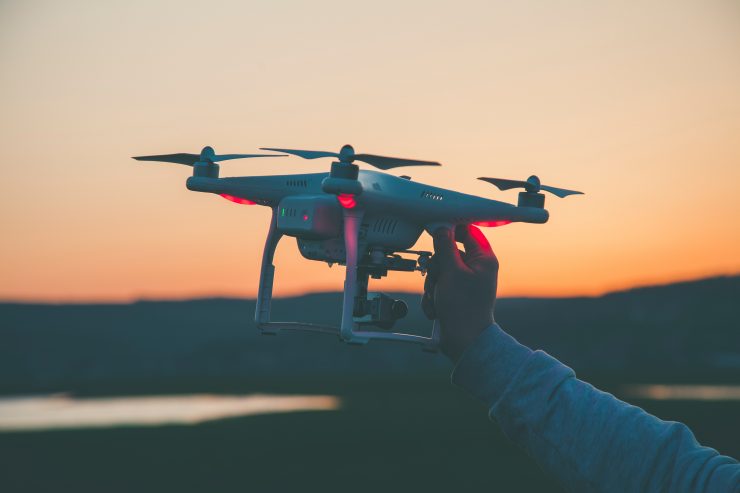A drone is one of the coolest gadgets you can get anyone today. Thousands of these gadgets take to the air every day, and people are finding new creative uses for them every other day. They are fun, handy, and easy to operate. However, while operating a drone from a joystick or tablet looks easy enough, the drone’s inner workings are a bit more complex.
In this article, you will get to learn what a drone is and get a behind-the-curtain look at how these gadgets work.
Defining Drones
A drone is an unmanned aerial vehicle – this means that it doesn’t need an on-board pilot to fly. Drones are controlled using joysticks or smart devices such as tablets and smartphones.
There are different types and sizes of drones. The largest drones are used for military purposes – some military drones can be as large as a Boeing plane! The second-largest drones are unmanned aircrafts. These are used in a wide range of industries and are preferable for their ability to cover large areas – such drones are often used for geographical surveying.
The most common consumer drones, which are also the smallest, are classified as VTOL (Vertical Take-Off and Landing) drones. They are small enough to carry by hand and are mostly used by consumers for personal and commercial purposes. Some mini drones and kids drones are so small they can fit into your pocket. You will often spot these drones hovering above parks and residential neighborhoods.
A Brief History of Drones
The first drones took to the air about 170 years ago, in 1839. They were crude and unsophisticated. They were essentially unmanned balloons filled with explosives. These original drones were used by Australian soldiers to launch an offensive against Venice.
We may never know when militaries started using drones. However, the supremacy battle can be dated back to 1982, when the Israelis used drones to launch an offensive against Syrian troops. Since then, drones have been used by major military players across the world, especially by the US and Russia. Military drones also helped pave the way for commercial consumer drones.
The first consumer commercial drone took to the air in 2006, when the Federal Aviation Administration issued the first permit. This opened doors to more and more consumers. Since then, the FAA has been issuing thousands of permits every year, and this number is expected to rise sharply as more and more people express interest in these flying gadgets.
How Drones Work – Breaking It Down
There are several aspects to how a drone works. It takes coordination in several levels to get these gadgets off the ground and cruising in the air. Here is an insight into how it all works:
Rotors
Most consumer drones sport four rotors that are used to fly the drones – this is why they’re also called quadcopters. The rotors comprise propellers attached to motors. To hover, the rotors generate a downward thrust that is equal to the gravitational pull. To ascend, the rotors generate a thrust greater to the gravitational pull, and to descend the exact opposite applies.
So, how do drones manager to hover over one spot without falling? It is also about physics. Two of the rotors rotate clockwise while the other two rotate counter-clockwise. This is meant to balance the sideways momentum of the drone so that it doesn’t lose its balance. When the drone starts moving in a vertical motion, two of the rotors (which to depends on the direction of flight) rotate faster than the other two to avoid throwing the drone off balance. It takes precision to keep the drone balanced.
Wireless Connectivity
Drones are controlled remotely from a joystick or smart device. This is made possible by GPS technology – other technologies, including laser and infrared, also help with control and direction. When controlling the drone from a smart gadget, the pilot uses a custom app. These apps can be pre-programmed with custom GPS coordinates to create an automated flight pattern. The pilot can also monitor vital data such as the drone’s power and its elevation, and they can get a live video feed from the drone’s camera.
Cameras
If asked, most people would say that the camera is the most important component of a drone. It is what makes flying these gadgets fun as pilots can get a bird’s eye view of the ground from elevated positions. Not all drones are camera drones, but most people want to use drones for photography.
Most of the emerging drones feature on-board HD cameras. However, users also have the option of installing their own cameras. The camera works with the drone’s network to transmit live video of the ground. Most consumers use this for fun or for photography purposes. However, on-board drone cameras are game-changers that can help with sensitive tasks such as search-and-rescue operations. Drones with cameras also raise some questions about privacy, which is why there are rules about where you can fly a drone.
Altimeter and Accelerometer
How well your drone flies depends on accelerometer and altimeter relays. An altimeter helps determine and control the drone’s altitude – it is important because a drone shouldn’t fly too high (to avoid strong winds and aerial obstacles) or too low (to avoid ground obstacles). The accelerometer, on the other hand, determines and controls the drone’s speed and direction.
Speaking of obstacles, some of the latest drones are fitted with technology that helps them to detect and avoid obstacles as they fly. They use a wide range of sensors, including:
- Monocular vision
- Infrared
- Lidar
- Vision sensors
- Time of Flight (ToF)
- Ultrasonic
Drones use these sensors to scan their surroundings as they look for obstacles. The visual scans are processed using SLAM technology and software algorithms to turn the scans into 3D maps highlighting everything in the drone’s vicinity. The drone then uses smart technology to avoid these obstacles by changing course of flight.
Communication Range Extension
Most consumer drones are limited to flying for short distances. If the pilot goes beyond the recommended distance, the connection between the drone and controller is lost. However, a drone’s distance range can be extended using a range extender. Extenders work with the 2.4 GHz frequency to facilitate communication between the drone and controller beyond the set distance range. Extenders can increase a drone’s flying range by as much as 700 meters, or over 2000 feet, but this depends on the type of drone and extender.
What happens when communication between the drone and controller is lost? Ordinarily, the drone would crash without a pilot to guide it. However, modern drones come fitted with a fail-safe function. If the connection is lost, the drone would return to its point of origin, also known as a home point.
The Future of Drones
Drones have a brilliant future full of possibilities. Demand by the commercial sector is pushing manufacturers to develop more sophisticated drones. In the future, consumer drones are expected to pack more power so that they can fly for prolonged periods. They will also have a larger distance range so that they can fly further. Hopefully, the intense competition going on today will also make drones cheaper and easier to get.
Businesses are coming up with new ways of making money with drones every other day. There are waterproof drones, fishing drones, selfie drones, and even Star Wars themed drones!
Final Word
Anyone can fly a drone, but it takes an inquisitive mind to learn the science behind these gadgets. Drones are evolving at a fast pace, so expect better gadgets over the coming months and years. Today, you can find quality drones that won’t break the bank. Check out the best drones under $200 and the best budget drones under $100.







Add comment